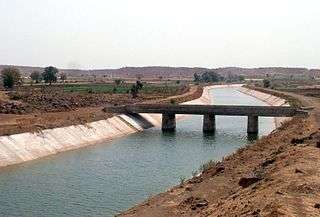Narmada Canal
| Narmada Main Canal | |
| Sardar Sarovar Canal | |
 View of the Kutch Branch Canal of Narmada Main Canal paved with concrete lining, meandering through northwestern India. | |
| Country | India |
|---|---|
| State | Gujarat, Rajasthan |
| River | Narmada |
| Source | Sardar Sarovar Dam |
| - location | Navagam, Gujarat, India |
| - coordinates | 21°49′49″N 73°44′50″E / 21.83028°N 73.74722°E |
| Length | 534 km (332 mi) |
| Width | 0.0731 km (0 mi) |
| Depth | 7.6 m (25 ft) |
| Volume | 1,132.66 m3 (40,000 cu ft) |
| Aforementioned information retrieved from the Narmada Control Authority[1] | |
The Narmada Canal is a contour canal in northwestern India that brings water from the Sardar Sarovar Dam north through 460 kilometres (290 mi) of the state of Gujarat and then 74 kilometres (46 mi) into Rajasthan state. It is the main canal of an irrigation system that has 42 branches, and runs a length of 750 kilometres (470 mi) (including field canals), resulting in a Culturable Command Area (CCA)[2] of 2,129,000 hectares (5,260,000 acres).[1]
Soon after the completion of the construction project, the Narmada canal was inaugurated on 24 April 2008.[3] The Narmada main canal is largest, longest irrigation canal. It has carrying capacity of 40,000 cusecs at its head in Navagam and is decreased to 2,600 cusecs at Sanchore. On the way, Narmada main canal crosses many rivers and water bodies. It is called engineering marvel because canal water reaches on elevated areas and canal has many pumping stations and NMC is concrete lined
Irrigation in Rajasthan
Since Rajasthan is arid and isn't even a riparian state, considerations were made to irrigate its lands with the water from the Narmada River that flows through the neighboring state of Gujarat. After traversing 486 kilometres (302 mi) in Gujarat, the Narmada canal enters Rajasthan near Shilu in the Sanchor tehsil of Jalore.[4] The 74 kilometres (46 mi) main canal, with 9 major distributaries, serves an area of 1,477 square kilometres (570 sq mi), including 124 villages.[5] In total, it was designed to irrigate 246,000 hectares (610,000 acres) in 233 villages in Jalore and Barmer and provide drinking water to 1,336 villages.[4] Saurastra Narmada Avataran Irrigation is a flagship program in this direction.
Prior to Narmada canal water, the Jalore and Barmer Districts of Rajasthan were irrigated mainly by wells that tapped into highly saline water, with 65% of the lands being barren and capable of growing only thorny trees.[6]
The Narmada canal has a few unique features compared to other projects:[7]
- Irrigation water is delivered to farmer groups, via Water Users Associations (WUA), not to individual farmers. WUAs are responsible for the operation and maintenance of field water canals.
- Micro-irrigation systems such as drip and sprinklers to be encouraged for efficient water usage.
Solar panels
Solar panels are being installed along a 1 kilometre (0.62 mi) pilot project section of the Sanand Branch Canal near Chandrasan village to generate 1 megawatt (1,300 hp) of electricity. The panels are forecast to also reduce evaporation of water from the canal by 9,000,000 litres (2,000,000 imp gal; 2,400,000 US gal) per year.[8][9]
See also
References
- 1 2 "Salient Features of Sardar Sarovar Project: Narmada Main Canal System". Narmada Control Authority (NCA). Retrieved 12 March 2015.
- ↑ "Glossary of terms". Water Resources Information System of India. Govt. of India. Retrieved 12 March 2015.
- ↑ "Field Visit Report: Narmada Command Project Area in Rajasthan" (PDF). Narmada Control Authority (NCA). Indore: Govt. of India. 9 May 2013. Retrieved 12 March 2015.
- 1 2 Parsai, Gargi (29 February 2012). "As Narmada water trickles in, life blooms in barren Jalore". The Hindu. Sanchor, Jalore. Retrieved 13 March 2015.
- ↑ "Narmada Canal Project". Water Resources Department. Govt. of Rajasthan. Retrieved 12 March 2015.
- ↑ Zaveri, Payal; Parmar, Ankita (Oct 2013). "Change in Cropping Pattern Utilizing Narmada Main Canal Water: A Case Study of Barmer District" (PDF). IJRET: International Journal of Research in Engineering and Technology. 02 (10): 99–105. doi:10.15623/ijret.2013.0210013. ISSN 2319-1163. Retrieved 12 March 2015.
- ↑ "Components of Project". Sardar Sarovar Narmada Nigam Ltd. Retrieved 13 March 2015.
- ↑ "Gujarat dedicates India's first canal-top Solar Power Project to the nation!". Narendra Modi. 23 April 2012. Retrieved 13 March 2015.
- ↑ Khanna, Summit (7 February 2012). "Solar power cells on Narmada canal to light up rural homes". dna. Gandhinagar: Diligent Media Corporation Ltd. Retrieved 13 March 2015.